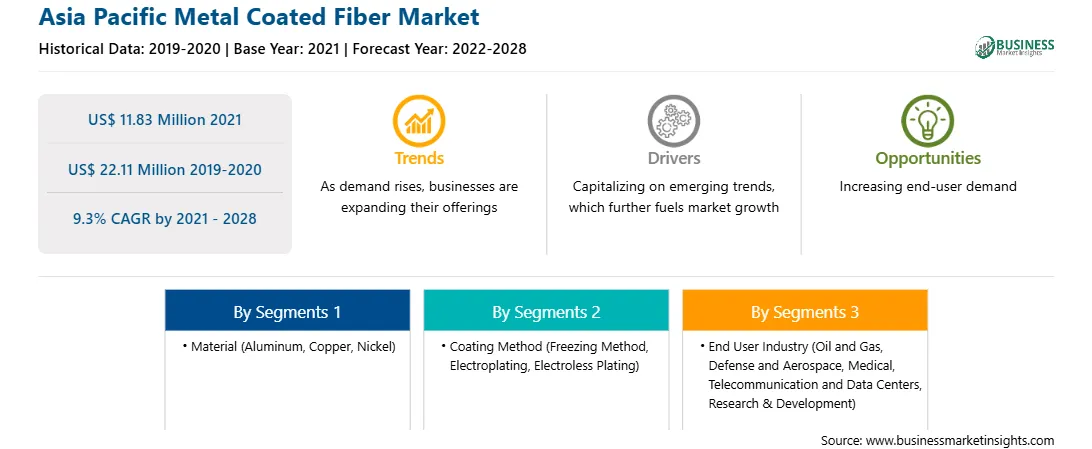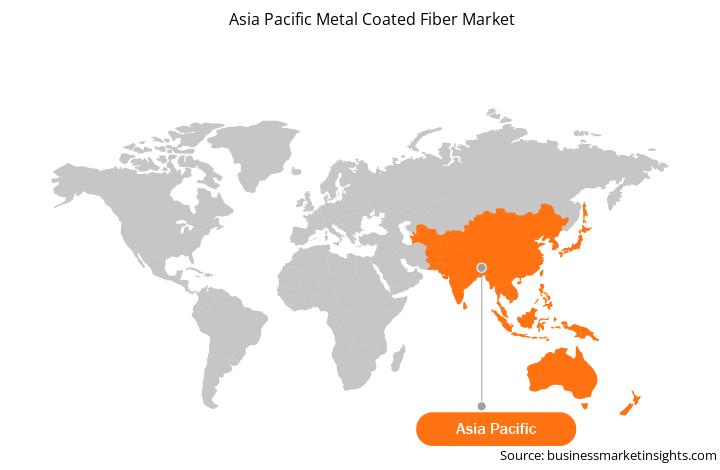Market Introduction
Asia Pacific comprises India, China, Japan, South Korea, Australia, and the Rest of Asia Pacific. The emerging countries are witnessing a surge in industrialization and urbanization activities, offering ample opportunities for the key market players in the metal coated fibers market. The metal coated fibers industry in APAC countries has experienced a considerable shift over the years. The massive growth of the market in APAC is due to the presence of manufacturing bases in emerging economies, such as India and China, and the fast-growing end-user industries such as oil & gas, aerospace & defense, and medical. Growing telecommunication industry is the major factor driving the growth of the APAC metal coated fiber market.
The COVID-19 pandemic has induced significant economic losses across countries in Asia-Pacific. The Asian economies have been hit hard due to the pandemic. Governing organizations across Asia-Pacific economies are adopting numerous strategies to restrict the spread of the virus, such as lockdowns, which directly impacted the growth of industrial sectors in 2020. The largest concentration of the fiber optics supply chain can be found in Wuhan, China. It is home to many companies, which together comprise 25% of the global optical fiber production capacity. The supply of optical fibers has been disrupted due to citywide quarantine in Wuhan. The various end-use sectors have been hit hard by the pandemic, impacting the consumption of metal coated fibers in the region. However, various countries from the region have restarted their business activities.
Market Overview and Dynamics
The metal coated fiber market in APAC is expected to grow from US$ 11.83 million in 2021 to US$ 22.11 million by 2028; it is estimated to grow at a CAGR of 9.3% from 2021 to 2028. Over the past decade, the use of optical fiber sensors by the oil & gas, nuclear, and chemical processing industries has grown dramatically. Hence, the demand for optical fibers capable of delivering their performance reliably in these challenging environments is also increasing. Typical telecommunications fiber starts degrading optically when used outside a specific temperature range and in certain environments with hydrogen, chemicals, or radiation. This creates a demand for metal coated fibers to address a greater temperature range and handle certain chemical environments. Few applications require the use of optical fiber specially coated with metal. For example, in the oil & gas industry, optical fibers are used for distributed temperature and acoustic sensing for multiple applications. The oil & gas industry uses downhole optical fiber in wells where temperatures can reach over 300°Celsius. Against such high temperatures, polymer-coated fibers do not keep their original mechanical properties. Therefore, Metal Coated fiber is used for high-temperature environments instead of polymer-coated fibers.There are various applications where optical fiber may get exposed to ionizing radiation, such as nuclear storage facilities and nuclear power plants. Such applications require optical fiber that has been explicitly designed to be minimally impacted by ionizing radiation. Compared with polymer coatings, Metal Coated optical fibers are sustainable in harsh environments such as high temperatures, highly concentrated chemicals, and nuclear radiation. Hence, the growing demand from harsh environment-related applications is driving the metal coated fibers market.
Key Market Segments
The APAC metal coated fiber market is segmented into material, coating method, end user, and country. Based on material, the APAC metal coated fiber memory market is segmented into aluminum, copper, nickel, and others. The aluminum segment dominated the market in 2020 and copper segment is expected to be the fastest growing during the forecast period. Based on coating method, the APAC metal coated fiber memory market is segmented into freezing method, electroplating, electroless plating, and others. The freezing method segment dominated the market in 2020 and segment is expected to be the fastest growing during the forecast period. Based on end user, the APAC metal coated fiber memory market is segmented into oil and gas, defense and aerospace, medical, telecommunication and data centers, research & development, and others. The freezing method segment dominated the market in 2020 and segment is expected to be the fastest growing during the forecast period.
Major Sources and Companies Listed
A few major primary and secondary sources referred to for preparing this report on metal coated fiber market in APAC are company websites, annual reports, financial reports, national government documents, and statistical database, among others. Major companies listed in the report are AFL; Arts Photonics GMBH; FORC- Photonics; Molex,LLC (Koch Industries, Inc.); OZ Optics Ltd.; Technical Fiber Products; and Thorlabs, Inc. are among others.
Reasons to buy report
APAC Metal Coated Fiber Market Segmentation
APAC Metal Coated Fiber Market –By
Material
APAC Metal Coated Fiber Market –By Coating Method
APAC Metal Coated Fiber Market –By End User Industry
APAC Metal Coated Fiber Market -By Country
APAC Metal Coated Fiber Market -
Company Profiles
Strategic insights for the Asia Pacific Metal Coated Fiber provides data-driven analysis of the industry landscape, including current trends, key players, and regional nuances. These insights offer actionable recommendations, enabling readers to differentiate themselves from competitors by identifying untapped segments or developing unique value propositions. Leveraging data analytics, these insights help industry players anticipate the market shifts, whether investors, manufacturers, or other stakeholders. A future-oriented perspective is essential, helping stakeholders anticipate market shifts and position themselves for long-term success in this dynamic region. Ultimately, effective strategic insights empower readers to make informed decisions that drive profitability and achieve their business objectives within the market.

| Report Attribute | Details |
|---|---|
| Market size in 2021 | US$ 11.83 Million |
| Market Size by 2028 | US$ 22.11 Million |
| Global CAGR (2021 - 2028) | 9.3% |
| Historical Data | 2019-2020 |
| Forecast period | 2022-2028 |
| Segments Covered |
By Material
|
| Regions and Countries Covered | Asia-Pacific
|
| Market leaders and key company profiles |
The geographic scope of the Asia Pacific Metal Coated Fiber refers to the specific areas in which a business operates and competes. Understanding local distinctions, such as diverse consumer preferences (e.g., demand for specific plug types or battery backup durations), varying economic conditions, and regulatory environments, is crucial for tailoring strategies to specific markets. Businesses can expand their reach by identifying underserved areas or adapting their offerings to meet local demands. A clear market focus allows for more effective resource allocation, targeted marketing campaigns, and better positioning against local competitors, ultimately driving growth in those targeted areas.

The Asia Pacific Metal Coated Fiber Market is valued at US$ 11.83 Million in 2021, it is projected to reach US$ 22.11 Million by 2028.
As per our report Asia Pacific Metal Coated Fiber Market, the market size is valued at US$ 11.83 Million in 2021, projecting it to reach US$ 22.11 Million by 2028. This translates to a CAGR of approximately 9.3% during the forecast period.
The Asia Pacific Metal Coated Fiber Market report typically cover these key segments-
The historic period, base year, and forecast period can vary slightly depending on the specific market research report. However, for the Asia Pacific Metal Coated Fiber Market report:
The Asia Pacific Metal Coated Fiber Market is populated by several key players, each contributing to its growth and innovation. Some of the major players include:
The Asia Pacific Metal Coated Fiber Market report is valuable for diverse stakeholders, including:
Essentially, anyone involved in or considering involvement in the Asia Pacific Metal Coated Fiber Market value chain can benefit from the information contained in a comprehensive market report.